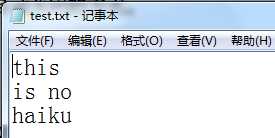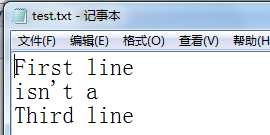标签:mod com 代码 处理 roc targe blog get readline
同样是《python基础教程(第二版)》的内容,只是后面内容学起来,相比前面会比较有趣,也更加实用,所以,将“基础”改为“进阶”。
python 电子书分享地址:http://yunpan.cn/Q2U87uGrNiTA3
本节讲文件的操作
-------------------------------
打开文件
open函数用来打开文件,语法如下:
open(name[, mode[,buffering]])
open函数使用一个文件名作为唯一的强制参数,然后返回一个文件对象。假设我要打开我硬盘(I:/python/test.txt) 文件,可以用下面方法:
>>> f = open(r‘i:\python\test.txt‘)
open函数中模式参数的常用值

基本文件方法
打开文件是第一步,下面就需要对文件进行读或写,可以write 和 read方法进行读或写。
#写入文件内容
>>> f = open(‘test.txt‘,‘w‘)
>>> f.write(‘hello,‘)
>>> f.write(‘world!‘)
>>> f.close()
# 读取文件内容
>>> f = open(‘test.txt‘,‘r‘)
>>> f.read(4) #读取前4个字符
‘hell‘
>>> f.read() #读取剩余的所有字符
‘o,world!‘
关闭文件
应该牢记使用close方法关闭文件。尽管一个文件对象在退出程序后会自动关闭,但关闭文件是没什么害处的,可以避免在某些操作系统或设置中进行无用的修改,这样做也会避免用完系统中打开文件的配额。
使用基本文件方法
假如test.txt文件包含如下内容:
-----------------------------
Welcome to this file
There is nothing here except
This stupid haiku
-----------------------------
下面是基本读文件的方法:
# read(n) 指定参数
>>> f = open(r‘I:\python\test.txt‘)
>>> f.read(7)
‘Welcome‘
>>> f.read(4)
‘ to ‘
>>> f.close()
# read() 不指定参数
>>> f = open(r‘I:\python\test.txt‘)
>>> print f.read()
Welcome to this file
There is nothing here except
This stupid haiku
>>> f.close()
# readline()
>>> f = open(r‘I:\python\test.txt‘)
>>> for i in range(3):
print str(i) + ‘:‘ + f.readline()
0:Welcome to this file
1:There is nothing here except
2:This stupid haiku
>>> f.close()
#readlines()
>>> import pprint
>>> pprint.pprint(open(r‘I:\python\test.txt‘).readlines())
[‘Welcome to this file\n‘,
‘There is nothing here except\n‘,
‘This stupid haiku‘]
readline返回一行的字符串, readlines返回包含文件所有内容的字符串列表, 每个元素是一行的字符串。
pprint 模块的pprint方法将内容分成每个小项单行显示。
下面是写文件的基本方法:
>>> f = open(r‘I:\python\test.txt‘,‘w‘) #默认是读文件,可以不加‘r’,写文件一定要加’w’
>>> f.write(‘this\nis no \nhaiku‘)
>>> f.close()

>>> f = open(r‘I:\python\test.txt‘)
>>> lines = f.readlines()
>>> lines[1] = "isn‘t a\n"
>>> f = open(r‘I:\python\test.txt‘,‘w‘)
>>> f.writelines(lines)
>>> f.close()

对文件内容进行迭代
1、接字节处理
最常见的对文件内容进行迭代的方法是while循环中使用read方法。例如,对每个字符进行循环,可以用下面方法实现:
f = open(filename)
char = f.read(1)
while char:
process(char)
char = f.read(1)
f.close()
read方法返回的字符串会包含一个字符,直到文件末尾,read返回一个空的字符串,char将变为假。
可以看到,char = f.read(1) 被重复地使用,代码重复通过被认为是一件坏事,看看下面的方法:
f = open(filename)
while True:
char = f.read(1)
if not char: break
process(char)
f.close()
这里break语句被频繁的使用(这样会让代码比较难懂),尽管如此,但它仍然要比前面的方法好。
2、读取所有内容
如果文件不是很大,那么可以使用不带参数的read方法一次读取整个文件,或者使用readlines方法。
#用read迭代每个字符
f = open(filename)
for char in f.read():
process(char)
f.close()
#用readlines迭代行:
f = open(filename)
for line in f.readlines():
process(line)
f.close()
3、用fileinput 来进行迭代
fileinput模块包含了打开文件的函数,,只需要传一个文件名给它
import fileinput
for line in fileinput.input(filename):
process(line)
4、文件迭代器
好吧!这是python2.2之后才有的方法,如果它一开始就有,上面的方法也许就不存在了。文件对象是可以迭代的,这就意味着可以直接在for循环中对他们进行迭代
f = open(filename)
for line in f:
process(line)
f.close()
再来看下面例子:
>>> f = open(r‘I:\python\test.txt‘,‘w‘)
>>> f.write(‘First line\n‘)
>>> f.write(‘Second line\n‘)
>>> f.write(‘Third line\n‘)
>>> f.close()
>>> lines = list(open(r‘I:\python\test.txt‘))
>>> lines
[‘First line\n‘, ‘Second line\n‘, ‘Third line\n‘]
>>> first,second,third = open(r‘I:\python\test.txt‘)
>>> first
‘First line\n‘
>>> second
‘Second line\n‘
>>> third
‘Third line\n‘
在这个例子中:
标签:mod com 代码 处理 roc targe blog get readline
原文地址:http://www.cnblogs.com/cmt110/p/7464830.html